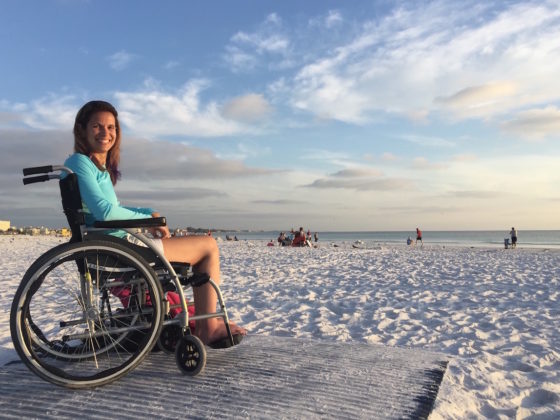According to the last US census, 18.7% of Americans have some sort of disability. Approximately 3.3 million Americans use wheelchairs for mobility, and an additional 6.5 million people in the US use a cane, a walker, or crutches to assist with their mobility. We are the largest minority group in the country, and ironically we are also the most invisible. Wheelchair users are the least represented minority in film and television, and even in the public space. You won’t see a representative sample of us out and about because many Americans with disabilities are too averse to the numerous remaining obstacles to accessibility, so they just stay home.

How Winning Ms Wheelchair USA Helped Me Realize How Far We Have to Go With Accessibility
Since becoming Ms. Wheelchair USA in July 2016, I have become intimately familiar with the provisions of the Americans with Disabilities Act (ADA), a landmark piece of legislation that codifies our equality, and also provides concrete guidelines for accessibility to businesses and public spaces. Having traveled to many countries in different parts of the world, I can say Americans with disabilities are the luckiest in the world to have these legal protections and provisions. However, that doesn’t mean we don’t have more work to do.
Before winning the pageant this past summer, I was already a public figure. As an expert on Mexico’s drug war, I have been a guest on virtually every major news network in the US, as well as on a few media outlets internationally. I have been traveling across the US for several years with my electric scooter for work, as I am unable to walk due to having multiple sclerosis (MS). I often ran into inconveniences in my hotel rooms or in the cities I was visiting, but rarely complained or pointed them out to anyone. I always felt like no one would care, let alone do anything to change or improve them.
But something fabulous happened during pageant week. As part of the program, we had an ADA attorney come speak to us about the intricacies of the ADA, and also what our rights are as Americans with disabilities. That, combined with winning the crown and sash, gave me the confidence to start speaking up about lapses in compliance by businesses. In 2016, I also started traveling much more extensively, both within the US and internationally, so I started making a point of applauding even the slightest efforts by the travel and hospitality industry to make life easier for Americans with disabilities — as well as highlighting instances that demonstrated how far we have yet to go.
Hotels are often the biggest culprits of inconvenience, if not outright noncompliance, with the ADA. I have come perilously close to injury in several hotel bathrooms (usually the shower/tub is the problem), and I have several friends in wheelchairs who have been seriously hurt as a result of careless maintenance or noncompliance with the ADA. It’s always clear when a hotel has failed to consult a person in a wheelchair when designing a hotel room. Often, beds are too high to transfer into, furniture blocks curtain pulls, or shower heads and faucets can’t be reached from benches.
Then come the problems with just navigating around American cities and towns. Wheelchair accessible taxis are frequently difficult to find, sidewalks are in various states of disrepair, historic areas are hard to reach, and older businesses that are not “grandfathered in” by the ADA either don’t know they need to be compliant, or can’t afford to be bothered to make the “reasonable effort” to install a ramp to their entrances or grab bars in their bathrooms. But even more injurious than the lack of access in so many places in the US is the too-common half-hearted apology, accompanied with the shoulder shrug that squeaks out, “Nothing we can do…”
Fortunately, some things are moving in the right direction. Despite the existence of the Air Carrier Access Act and US airlines’ best attempts to comply with the ADA, air travel for people in wheelchairs is frequently a nightmare — usually due to our inability to use inaccessible bathrooms on planes. However, after many years of roadblocks and lobbying, the US Department of Transportation’s ACCESS Advisory Committee — which includes airline representatives, flight attendants, and people with disabilities — revealed they plan to make bathrooms on single-aisle aircrafts more accessible for those in wheelchairs or who need extra assistance on board. Google Maps recently started including the accessibility of local businesses in their searches. Half of all New York City yellow cabs will be wheelchair accessible by 2020 under a historic agreement between advocates for the disabled and the city.
But there is so much more that needs to be done. Despite my increased visibility as Ms. Wheelchair USA, I’m just one person in a wheelchair. As the largest minority group in America, it is incumbent upon those of us with disabilities to not only know our rights, but to speak up and advocate for ourselves whenever possible. I’ve been able to initiate changes in online ticketing practices at a theme park and physical access to soap and towel dispensers in accessible airport bathrooms just by speaking up through social media. Even though we don’t all have a pageant title or a crown and sash, we all have a voice, and I’m learning every day how to best use mine to advocate for Americans with disabilities.